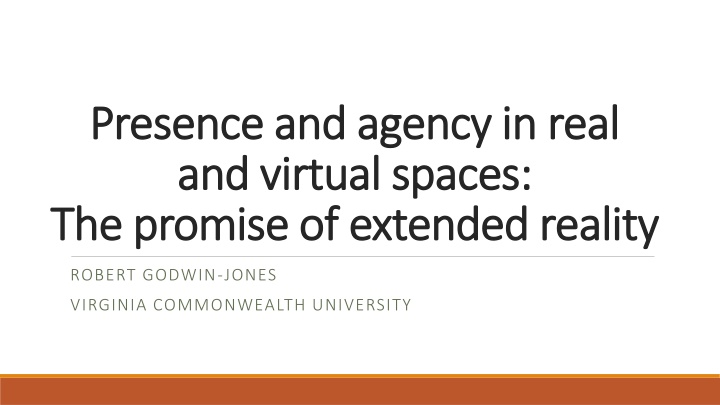
Exploring Presence and Agency in Extended Reality
This article delves into the realm of extended reality (XR), encompassing augmented reality (AR) and virtual reality (VR), and their potential in enhancing learning experiences. It discusses how AR enhances real spaces through smartphone cameras, while VR fully immerses users in 3D environments. The text also explores the applications of AR in guided tours and place-based games, emphasizing experiential learning. Additionally, it addresses the history and potential of VR in language learning, highlighting the challenges and opportunities associated with this technology.
Download Presentation

Please find below an Image/Link to download the presentation.
The content on the website is provided AS IS for your information and personal use only. It may not be sold, licensed, or shared on other websites without obtaining consent from the author. If you encounter any issues during the download, it is possible that the publisher has removed the file from their server.
You are allowed to download the files provided on this website for personal or commercial use, subject to the condition that they are used lawfully. All files are the property of their respective owners.
The content on the website is provided AS IS for your information and personal use only. It may not be sold, licensed, or shared on other websites without obtaining consent from the author.
E N D
Presentation Transcript
Presence and agency in real Presence and agency in real and virtual spaces: and virtual spaces: The promise of extended reality The promise of extended reality ROBERT GODWIN-JONES VIRGINIA COMMONWEALTH UNIVERSITY
Real and imagined spaces for learning What is extended reality? References both augmented reality (AR: smartphone) and virtual reality (VR: headset) Powerful engines for SLA: place-based, immersive, and/or collaborative learning What doses AR do? AR: enhances/annotates real spaces, most often through smartphone camera Adds information to the view of a real place (note, translation, image, animation, video) What does VR do? Fully immerses users in a 3D environment, headset plus controllers Headsets range from rudimentary (Google Cardboard) to elaborate (Meta Quest Pro)
Augmented reality How it works Annotation triggered by marker (image, QR code) or by location (GPS) More accessible than VR; likely familiar from Pok mon craze of 2016; used in shopping Most common use is guided tour, scavenger hunt, historical view Mobile trails can combine marker (on signs) and geo-location triggers Can provide both L2 and culture learning, optiosn for multilingualism, site history Place-based games Experiential learning in/outside classroom, potential for peer collaboration, engagement Mentira: learners try to solve a murder mystery; clues through right pragmatic choices
VR and language learning Longer history than AR (back to 1970 s) Early waves used text-based simulations, then synthetic realities (Second Life) Targeted experiential, experimental, and collaborative learning Situation today Cost, comfort, compatibility remain roadblocks; no widespread usage However, newer headsets hold promise (but has been on the verge for long time) Targeted areas in commercial VR applications Vocabulary learning: enhanced multimedia interactions, image, sound, video Role-play in simulated, immersive scene, can be real (restaurant) or imaginary (aliens)
Directions in VR Has it fulfilled its potential for language learning? Recent meta-analyses: VR apps incredibly limited in scope and application Lack of imagination in exploiting whole body movements, gestures, collaboration Optimized uses Collaborative storytelling using rich multimedia, pragmatic language development Global simulations ; kinesthetic/tactile learners; individualized learning pathways Enhancing pragmatic language learning Integration of VR into virtual exchanges, powerful but cost/compatibility difficult Gaming with wrap-around activities from Minecraft to World of Warcraft
The dynamics of VR Presence Full immersion provides the illusion of non-mediated connectivity; take on identity Potential for flow experience => complete focus/engagement; if L2, time on task Copresence Social interactions through avatars taking on different roles; collaborative tasks Gaming also can provide collaborative opportunities; individual differences significant Motivation Can be highly motivating if game elements included, lessons from informal L2 learning Students more engaged if co-creation options possible (local authoring)
Practical concerns Constraints Cost, accessibility, likelihood of equipment obsolescence; functionality may not fit need Physical discomfort including disorientation, fatigue, nausea Comfort level May not appeal to all students; most appealing likely to experienced gamers Advisable to have non-VR alternatives whenover possible Cognitive overload Combination of challenges with L2 and new tech at the same time Learner training needed, provided in advance, could be in L1
VR apps Role play Mondly ImmerseMe Peer collaboration Immerse vTime 360 videos WondaVR Google StreetView
Future: Mixed reality? What is it? Ability to access through either AR or VR HoloLens, Magic Leap, Vision Pro Combining the strong points of each Able to view immediate surroundings, but also to immerse on demand Integrates more easily into everyday life; potentially less geeky Ambient intelligence Internet of Things: Smart glasses, cars, home => sensors, cameras, microphones always on Some headsets with integrated physiological sensors => affective computing
VR and AI AI becoming more widely integrated Built in to voice assistants and also into chatbots in VR Chatbots moving away from closed, scripted systems to free-form conversation Smart avatars Rich use of customizable multimedia (synthetic voice, lip syncing, facial recognition) Makes conversation closer to real life conditions Sophisticated role play ChatGPT able to take on multiple identity roles Game of quest with AI version of a favorite fictional character, engaged in L2 talk
